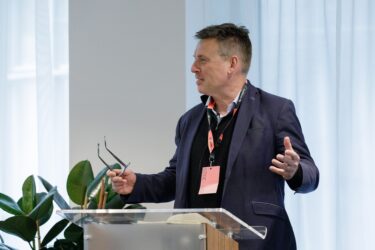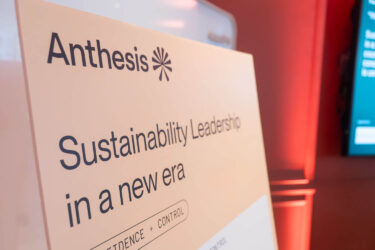
Contents
- Return on investment
- Decarbonisation projects
- Capture financial benefits
- Consider your people
- Your local context
- Contact us
Share this article
Anthesis Director for Energy Chris Paddey, shares why business-as-usual investment decisions are locking in problems for the future.
In recent years, thousands of companies have pledged to hit Net Zero by 2050 or even 2030.
For Chief Executives eyeing the next set of financial results, these dates will likely seem a very long way off, giving them plenty of time to figure out how exactly they will meet their corporate pledges.
But striking pledges to reduce emissions and the difficult work of implementing the changes needed to meet these commitments are two very different things. Through our work, we often find that companies have yet to fully understand how much money they will need to invest to meet their ambitious pledges and underestimate the scale of ambition needed to decarbonise their business.
Whilst it is understandable that organisations have a wide range of priorities, this lack of long-term planning means that many of the investment decisions being made today are locking in problems for the future and may make meeting those commitments all but impossible.
Many businesses are not aligning their investment decisions with the need to significantly lower carbon operations over the long term. Investments in plant, machinery and buildings will be made based on that asset performing over 15 or even 20 years. So a poorly thought-out investment decision made today may result in a failure to meet emissions targets or having to put up with a stranded asset that is unfit for a lower carbon future.
We recently advised the Chief Executive of a large multinational on whether he should commit to a significant investment in a new combined heat and power system for his factories. The technology could do the job, was well understood by his engineering team and would deliver a return on investment in just a few years. But the system was powered by natural gas. It also had an expected lifecycle of around 15 years. We advised the chief executive that if he signed up to the new system, he would have to wave goodbye to his Net Zero commitment.
More and more companies are signing up to the Science Based Targets initiative, where signatories commit to creating short-term milestones to reducing their scope 1, 2 and 3 emissions. This will make it harder and harder for companies to hide if they do not have a coherent and ambitious investment plan to reduce emissions.
Despite the challenges, business leaders cannot simply ignore the problem of how they will meet their Net Zero commitments. Here are six ways that business leaders can ensure they make credible and profitable investments that help them hit their long term goals:
1. Consider a longer return on investment
One of the biggest issues holding back companies investing in green technologies is short-term thinking. Investments made today need to be made in the context of longer-term decarbonisation targets to ensure that fixing today’s problem does not inadvertently embed a new problem for tomorrow.
Many companies are still stuck in a cycle of Return-on-Investment economics with business leaders assessing the viability of projects on whether they make a return on investment in just two or three years. Yet many of the emerging technologies that will allow companies to decarbonise their assets are still at the stage that will only pay back after five or even ten years.
Yet there are businesses that are bucking this trend. Leaders in the field are implementing much more flexible investment hurdle rates and/or accessing dedicated financial products that incentivise decarbonisation and many of our clients have had considerable success with moving to ten-year paybacks for projects that fit their decarbonisation agenda.
2. Put money aside for decarbonisation projects
Short-term thinking is also compounded by a lack of ring fencing for decarbonisation projects.
Managers typically have to bid for decarbonisation projects against a wide range of capital investment projects, from general maintenance works to upgrading servers to buying new buildings. It often means that what are seen as essential works take priority over more difficult long-term decarbonisation projects.
But if business leaders are to hit their Net Zero goals, decarbonsiation projects cannot continue to be ignored. As such, leaders in the field are isolating low-carbon investment outside of the standard considerations for business investments. In effect, companies need to ring fence funds for investment in low or zero carbon technologies outside of their normal capex budget.
3. Capture all the financial benefits of decarbonisation projects
Decarbonisation projects often have benefits that are not captured through traditional accounting methods. They may boost a company’s green credentials allowing them to sell their product for a higher price; reduce overall spending on carbon offsets; or allow the company to access more favourable loan or banking covenants.
For instance, in the manufacturing sector, Environmental Product Declarations and Lifecycle Carbon Assessments are increasingly popular. These require companies to report on the embodied carbon in their products, which means that decarbonising the production process can improve ratings and boost competitive advantage.
As such, if companies want to make a strong case for investing in carbon reduction projects, they need to capture all the financial benefits that these investments will bring to their business. This can be done through life cycle assessments of project benefits, as well as taking into account the costs of offsets and different types of financing.
Many businesses also fail to capture the real cost of carbon to their business both today and in future years as carbon markets tighten.
Building a cost of carbon into the business model is an effective way for companies to compare new and emerging technologies with older more carbon-intensive ones. Again industry leaders are already embedding the cost of carbon into business cases through internal carbon pricing, sometimes with a price of over $100 per tonne of CO2 emitted.
4. Consider your people
We also find that there can be a real disconnect between the pledges made at the very top of an organisation and the people who often pitch for capex spending.
These employees may have little knowledge of the wider green agenda within their own company and many of the new low carbon technologies may also seem more inherently risky to them. The technology of a gas fired heating system for a large office block is entirely different to using an electric powered heat pump for the same building. Instead of ‘fit and forget’ systems, engineering teams may also need to upskill for the design, install and ongoing maintenance required of the new technology.
As such, it is important to think about how you can get your employees on board with the decarbonisation agenda and ensure they have the skills necessary to make those projects a long-term success.
5. Look at your local context and get specialist advice
It can also be difficult for people who are not specialists in this field to know what the most effective decarbonisation solutions are.
The policy and incentive landscape differs from country to country and often changes from year to year. In most companies, a jigsaw of different solutions is required with different technologies deployed depending on the local context; while an electric heat pump may be the greenest way to heat a factory in the UK, it probably will not be in Poland where the electricity grid is still largely powered by coal.
There may also be unintended consequences to green projects, such as impacts on local nature or difficult to dispose of waste – all of which need to be factored in at an early stage.
Through our work, we find that one size rarely fits all, which means that advice from specialists in the field is often a must.
We are the world’s leading purpose driven, digitally enabled, science-based activator. And always welcome inquiries and partnerships to drive positive change together.




